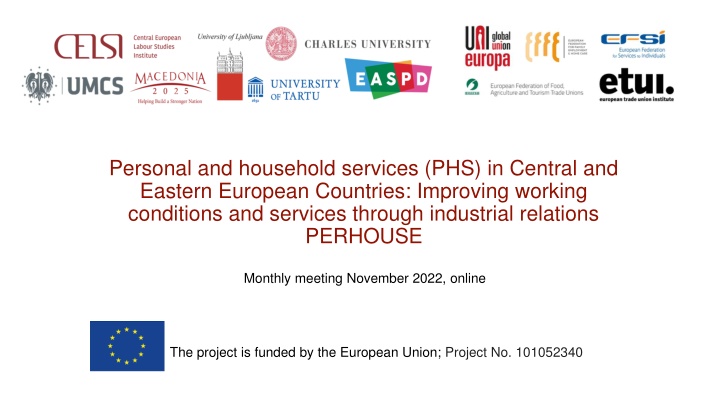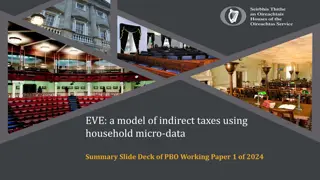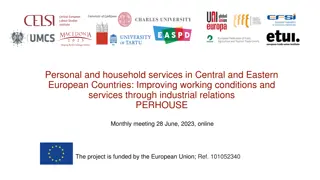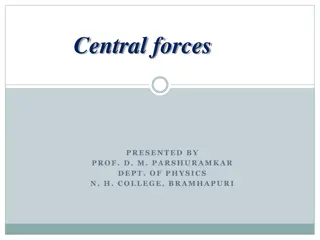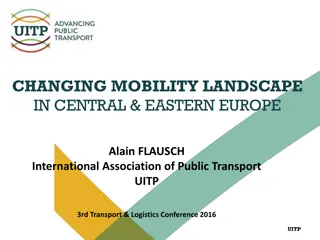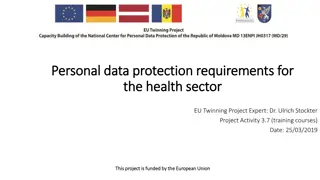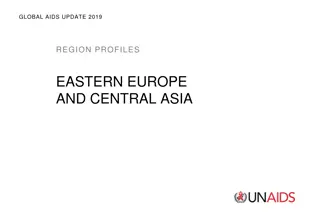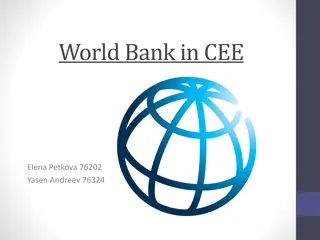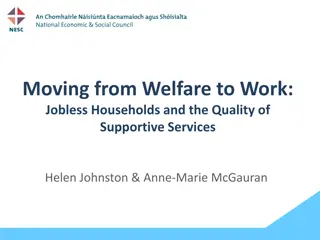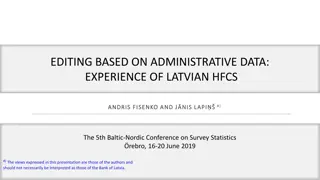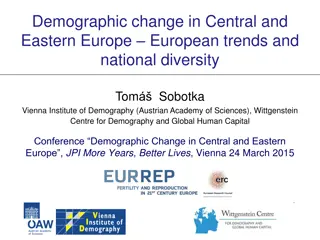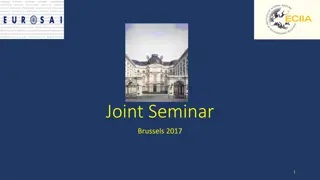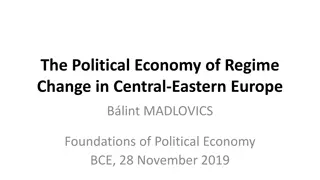Improving Conditions in Central & Eastern European Personal and Household Services Sector
Exploring industrial relations to enhance working conditions and services in Central and Eastern European personal and household services sector. Objectives include addressing challenges, deepening IR analysis, promoting awareness, and comparative analysis of national experiences. Research questions focus on service provision, working conditions, and the role of social dialogue in regulating the PHS sector in CEE countries.
Download Presentation

Please find below an Image/Link to download the presentation.
The content on the website is provided AS IS for your information and personal use only. It may not be sold, licensed, or shared on other websites without obtaining consent from the author.If you encounter any issues during the download, it is possible that the publisher has removed the file from their server.
You are allowed to download the files provided on this website for personal or commercial use, subject to the condition that they are used lawfully. All files are the property of their respective owners.
The content on the website is provided AS IS for your information and personal use only. It may not be sold, licensed, or shared on other websites without obtaining consent from the author.
E N D
Presentation Transcript
Personal and household services (PHS) in Central and Eastern European Countries: Improving working conditions and services through industrial relations PERHOUSE Monthly meeting November 2022, online The project is funded by the European Union; Project No. 101052340
Meeting agenda (?) State of play of the project - WP2 Literature review- discussion on the draft Discussion on the draft analytical framework - postponed Structure of the survey(s) discussion - postponed WP3 role and responsibilities of EASPD and CUNI Next steps and end of the meeting
Objectives and aims General objective: To explore industrial relations to improve the working conditions and services in the PHS sector of CEE countries. Reminder: the core is to investigate the IR, but before that, the complex description of the PHS sector needs to be provided. Aims Address the challenges of working conditions and services in the PHS sector of CEE countries. Deepen the industrial relations (IR) analysis and the potential of social dialogue in the PHS of CEE countries. Provide a comparative analysis of national experiences in IR and working relations in PHS and explore the link to EU-level social dialogue structures. Promote awareness of the industrial relations practices related to the PHS sector.
Specific objectives Interrelated objectives informing each other. Compare national experiences in IR and working relations and link to EU-level social dialogue structures. Analysis of industrial relations and the potential of social dialogue Address the challenges of working conditions Promote awareness Identify the social actors representing workers and employers Explore the demand and EU stakeholders views Conceptualisation EU and national collaboration Scope, sub-sectors, size Explore the discourse on PHS IR links to EU SD and IR Discussion on EU regulations Fill the gap in research. Identify the barriers of low representation + solutions EU employment policy and IR as a response (?) Increase of acknowledgement Identify challenges
Research questions Stay on the right track to find the answers to the research questions: RQ1) What is the current state and structure of service provision of PHS in CEE and what are the working conditions in the PHS sector? RQ2) What is the role of social dialogue in regulating and improving the work patterns in the personal and household services (PHS) sector of domestic workers in Central and Eastern European countries (CEE)? NM and other partners indicated that the IR in PHS are limited, and the SD is absent due to prevalent informal services, self-employment, and a relatively generous social security system. The limits and the reasons of SD will be described in the national reports as well.
WP2 analytical framework, comparative data, data collection tools 2.1. Literature review Review the previous studies on the industrial relations in the PHS sector in the 12 countries and identify who are the social actors representing workers and employers, including state) 2.2. Explore the scope, subsectors (care and non-care) and estimate the size of the PHS sector in the 12 countries based on the EU comparable and national data Comparable data 2.3. Prepare all the tools for data collection: survey questionnaire on demand in 12 countries, survey questionnaire among stakeholders for 12 countries, interviews guide on stakeholders views (EU and national levels) and guide for the focus groups, the structure of the national case studies. All partners will be involved in this task and comment on the analytical tools. Conceptual and analytical framework
WP2 Deliverables and responsibilities D2.1. Working paper on conceptualisation of the PHS sector in CEE - M6 (1/23) The paper is based on the literature review and will encompass all the main findings and set the PHS sector's central concept and future analysis. The working paper aims to provide a comprehensive framework for the upcoming research activities of the consortium. The format is electronic, English language). . D2.2. Methodological tools (survey, interviews, focus groups, outlines) - M6 (1/23) DD is January 23 This deliverable contains all data collection tools for the tasks in WP3 and WP4: Online survey for social partners and stakeholders in 12 CEE; Online survey to study the demand for PHS in 12 CEE; Interview guide for EU-level stakeholders will be prepared by CUNI Three focus groups interview guides with domestic workers (child care, LTC, non-care services); Structure of the national case studies Responsible: CELSI (lead) in cooperation with all benefitiaries: UT, CU,UL,UMCS, MK2025, EASPD
Literature review Methodology Key words: Personal and household services, Europe, Central European Countries, care and non-care services, care economy, domestic work, . Second level key words: structure, employment, service provision, financing, working conditions, services quality, employment quality, Third level key words: industrial relations. social partners, unionisations, representatives, social dialogue, social actors, collective agreements Sources/databases search strategy Desk research based on the available academic and policy studies, media articles, regulations, project outputs, etc. Statistical evidence on the PHS sector and domestic work in CEE countries (e.g. structure of service provision and financing, working conditions, employment trends and structures); Inspecting the available data at the European level and/or national data for its comparability; Sources: scientific databases, ResearchGate, Academia, Journals, . Geographical coverage EU and CEE region (SK, PL, HU, HR, SI, BG, LT, LV, RO, CZ, EE, and North Macedonia);
We are looking for the CEE specificities The added value of the project is to focus on CEE countries to fill the knowledge gap on IR and PHS in the CEE countries To find overview studies on the whole region or specific CEE countries We are searching for the CEE region specificities regarding PHS provisions, structure, employment models, interrelation to the social security system, care drain, care gap, etc. To have in mind: Challenge the assumptions on CEE regions as a region in constant transition and the often outdated perspective of the Western countries on the Ost-block Verify the assumption that the working conditions in (non)public services are better than in private/non-public services
Literature review Themes researched: Themes researched: Scope/ definitions of PHS Structure of PHS Care and non-care Direct and indirect Formal and informal Employment models Working conditions - wages Quality of employment Quality of services Social security system to be included Governance/policies/regulations EU level CEE level National level as sources for the partners Theories related to PHS Economic perspectives (commercialisation) Gender/feminists perspectives (social reproduction) Migration studies Anthropological studies Industrial relations/social dialogue International/EU level National level Potential of PHS Job creation Work life balance Women s employment gender equality Demand Supply Data and measurement Statistical definitions NACE classification ISCO nomenclature Estimations of the size (CEE?)
Scope/definitions of the PHS sector At the kick-off meeting, we agreed that will not devote too much time to the scope of the sector, however, the scope and the subsectors are relevant the design the surveys, interviews and find the right stakeholders. The European Commission (2012) defines PHS as a broad range of activities that contribute to wellbeing at home of families and individuals: childcare, long-term care (LTC) for the elderly and persons with disabilities, cleaning, remedial classes, home repairs, gardening, ICT support, etc. The European Federation for Services to Individuals, an organisation representing federations and companies of personal services in Europe, clusters these activities based on two sub-sectors. It defines personal and household services (PHS) as: activities carried out mainly in users homes relating to personal assistance services (early childhood, child care, dependence, disability, invalidity, etc.) summarised under the term care-related services and to services of daily living (cleaning, ironing, gardening, small DIY, maintenance, remedial classes, etc.) united under the term household support . (Decker and Lebrun 2018). Domestic work describes all work performed in or for a household(s), following the ILO s Domestic Workers Convention no.189/2011.
Scope/definitions of the PHS sector Eurofound - 2001 report on employment in household services : All those services provided by public or private organisations, or by the third sector, which substitutes paid work (in the form of a job or self-employment) for work which was formerly performed unwaged within the household. Therefore, all services provided inside and outside the home of the user are included, as long as they maintain and support members of a private household (Cancedda, 2001) The definition of Eurofound partly responds to the questions of how unpaid work is interrelated to the PHS. Vague definitions: These different approaches converge in regrouping in a single encompassing category of personal and household services (PHS) a series of services provided at the beneficiaries home, either care services or comfort services; these services are provided by a third actor and they participate to the well-being of persons (European Commission, 2015).
Scope/definitions of the PHS sector Definitions/scope based on listing the services (taxonomy/classifications) ILO https://www.ilo.org/global/topics/domestic-workers/who/lang--en/index.htm Domestic workers are those workers who perform work in or for a private household or households. They provide direct and indirect care services, and as such are key members of the care economy. Their work may include tasks such as cleaning the house, cooking, washing and ironing clothes, taking care of children, or elderly or sick members of a family, gardening, guarding the house, driving for the family, and even taking care of household pets. A domestic worker may work on full-time or part-time basis; may be employed by a single household or through or by a service provider; may be residing in the household of the employer (live-in worker) or may be living in his or her own residence (live-out). A domestic worker may be working in a country of which she/he is not a national, thus referred to as a migrant domestic worker.
Structure/sub-sectors Care and non-care Non-care household services are usually defined as object-centred activities that support daily living, and which are mainly carried out in the home of a customer, sometimes also referred to as indirect care (OECD, 2021) The term non-care household services might be construed as devaluing the work in the sector. To emphasize that non-care services are as valuable as care services, the ILO in its definition of domestic workers considers they provide both direct care (care for the elderly, persons with disabilities or children) and indirect care (cleaning, housekeeping, gardening), see ILO (2018) However, exact definitions vary across countries as they are typically tied to specific policies and instruments in this sector. Often lumped together with care-related work under the umbrella Personal and Household Services (PHS), these activities aim to improve the well-being of households and/or support its maintenance. The main activities captured by the non-care household services label range from cleaning and ironing to maintenance and smaller repair work as well as gardening. Yet data sources and policy instruments do not always distinguish between care-and non-care types of service provision and providers may also deliver both types of services (Baga et al., 2020)
Structure/sub-sectors Care and non-care Sometimes the non-care services are labelled as comfort services in terms of complementing the care services within the household realms (European Commission, 2015). The comfort services are understood as those which should ensure comfort for the dependent persons who are cared for. Today we do not use the term comfort services, but recognise the tight connection of the care and other housedhold services such as preparing food while caring for a child,etc. Distinguishing between care and non-care activities is difficult, as the same activity, e.g. preparing meals or cleaning the house, can be considered as part of the overall care provided to a dependent person or could be considered a convenience or comfort services if the beneficiary is not in a frail situation. The state of the recipient of personal service is therefore important and may contribute to defining the nature of the service (European Commission, 2001). Formal/informal (informal = undeclared overlapping with unpaid done by relatives) Informal might also equal unde-declared work, i.e. when the workers might be paid but not in the whole range of work services they provide. Informal, undeclared work involves workers (and their employers) who do not declare part of their earnings or do not declare their earnings at all. In the absence of taxation of labour income, those engaged in informal and undeclared work will have higher take-home pay than otherwise similar workers, but this comes at a price. Informal work is not covered by social protection arrangements in the area of health, unemployment and pensions.( OECD, 2021).
Structure/sub-sectors Task: to develop overall scheme for the project, but partners might modify based on their country specificities M ria Sedl kov , 2020. "Job Quality and Industrial Relations in the Personal and Household Services (PHS-QUALITY), National report: Slovakia," Research Reports 34, Central European Labour Studies Institute (CELSI).
Interaction and interdependence between the public sector and PHS PHS sector services provided in the households Undeclared work Informal care Task: to develop an overall scheme for the project, but partners might modify based on their country specificities Non-care Care Public and non public providers Health care Childcare (kindergartens) Modified - Guzi, Holubov , Kahancov , Kahanec, Marti kov , Radvansk , Bors, Schonenberg (2022) Tackling undeclared work in the personal and household services sector. ELA. At: https://www.ela.europa.eu /sites/default/files/2022- 03/UDW_Study_report_o n_PHS_2022.pdf Social care Institutions
Data and measurement - following the scope (?) The data available have its limitations and probably will not fully reflect perfectly the whole scope of the activities that we will include in the PHS scope we need to make this transparent and admit the limitation when estimating the size . NACE - the Statistical classification of economic activities The narrow PHS definition includes NACE subsectors Q88 Social work activities without accommodation and household employment defined as T97 Activities of households as employers of domestic personnel. The broad PHS definition includes, in addition to the above, the S95 Repair of computers and personal and household goods and S96 Other personal service activities. Care activities in the PHS sector are defined within two categories in NACE: Q88 Social work without accommodation mostly related to non-residential (long-term) care activities for dependent, disabled or elderly individuals and children (including nurseries); and partially (around a quarter) in T97 Activities of households as employers of household personnel (e.g., cleaning, gardening, health-related personal care, child care etc.). (Guzi, 2022) The household activities in T97 include direct household employment, while social care activities in Q88 cover both household employment and the provision of non-residential care by care institutions and organisations. Additionally, care activities in Q88 can be subdivided into supporting and long-term care activities. (Guzi, 2022) Three NACE subsectors define the non-care activities in the PHS sector: S95 Repair of computers and personal and household goods; S96 Other personal service activities (e.g., hairdressers, nail bars) (Guzi, 2022)
Data and measurement - following the scope (?) ISCO - the International standard classification of occupations To give a more accurate representation of employment in the PHS sector, we can also rely on the International standard classification of occupations (ISCO) to assess the number of jobs in the sector and workers profiles (Decker, Lebrun, 2018). This occupational approach is not entirely satisfactory either as there is no perfect correspondence between the various PHS activities with the list of occupations. Still, it reveals to be closer to reality than NACE statistics. In this case, it is no longer the type of employment (direct employment model vs. provider employment model) which will be decisive but rather the occupation, whether it is a care-related or a household support-related job. In this case, three groups will be particularly important (Decker, Lebrun, 2018). Group 9111 of domestic cleaners and helpers . This group includes domestic cleaners and helpers sweep, vacuum clean, wash and polish, take care of household linen, purchase household supplies, prepare food, serve meals and perform other domestic duties . Group 5311 of Child Care Workers is defined as providing care and supervision for children in residential homes and in before-school, after-school, vacation and day-care centres . Group 5322 of home-based personal care workers which are defined as providing routine personal care and assistance with activities of daily living to persons who require such care due to effects of ageing, illness, injury, or other physical or mental conditions, in private homes and other independent residential settings .
Data and measurement - following the scope (?) ISCO - the International standard classification The use of "4-digit" data raises issues of sample size and collection and Eurostat data related to the ISCO classification are not available for all Member States and we have to rely on the broader category PHS occupations in the ISCO statistical nomenclature 53. Personal care workers 531. Child Care Workers and Teachers Aides 5311. Child Care Workers 5312. Teacher s Aides 532. Personal Care Workers in Health Services 5321. Health Care Assistants 5322. Home-based Personal Care Workers 5329. Personal Care Workers in Health Services Not Elsewhere Classified Missing data substituted, e.g: European Federation of Cleaning Industries (EFCI) - data representing the sub-category 9112 of Cleaners and Helpers in Offices, Hotels and Other Establishments 91. Cleaners and Helpers 911. Domestic, Hotel, and Office Cleaners and Helpers 9111. Domestic Cleaners and Helpers 9112. Cleaners and Helpers in Offices, Hotels and Other Establishments 912. Vehicle, Window, Laundry and Other Hand Cleaning Workers 9121. Hand Launderers and Pressers 9122 Vehicle Cleaners 9123 Window Cleaners 9129 Others Cleaning Workers. Partner from EE indicated microdata for EE - NACE for all companies and ISCO for all employees. SI partner questioned some categories, as the services need to be provided in the household as the defining characteristics of the PHS) to be verified if all the categories comply with this criterion. . (Decker, Lebrun, (2018)PHS monitor http://www.efsi- europe.eu/fileadmin/MEDIA/publications/2018/PHS_Industry_monitor_April_2018.pdf
Issues for discussion CEE as donors and receiving countries Transnationalisation of care and care relocation Care drain, care gap, migrant labour Working conditions of carers from CEE in other countries Representation of CEE carers working abroad and TCN carers in CEE The same for non-care PHS (?) Sources: Ezzedine, P., Krause, K. (2022). Profitable Bodies and Care Mobilitiesin Central and Eastern Europe https://www.relocatingcare.org/ https://www.care4care.co.uk/
Issues for discussion WP3 role and responsibilities of EASPD and CUNI According to the project description: EU level interviews will be realised by the expert from CU in coordination with EASPD. The EU level interviews will capture the EU level stakeholders views on the PHS sector in the CEE countries. CUNI researchers will conduct interviews. Stakeholders will be selected based on their relevance for the sector, the selection will be coordinated with the EASPD and associated partners (EFSI, UNI ETUI, EFFAT and EFFE, etc.). The number of interviews: 10. D3.1. EU Stakeholder views study, CU/EASPD: The study will be based on the analysis of the 10 interviews with the EU- level social partners and stakeholders relevant to the PHS sector. Data from the online survey among stakeholders will also be included. Format electronic, English language. CUNI will prepare the draft of the interviews based on the relevant lit. on interrelations of the EU level and PHS in CEE. CUNI asked the partners for suggestions related to relevant documents linked to thier country PHS agenda and EU. The draft interview guide to be feedbacked by other partners by 15 of FEB 23.
Issues agreed and follow up: The draft lit. the review is to be sent to partners for comments by the end of 2022 latest The next monthly meeting will be in the first week of 2023 The WP2 Deliverables are to be finalised by the end of January 2023
